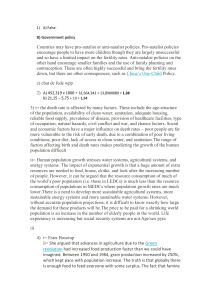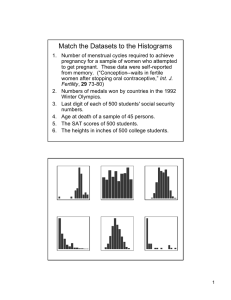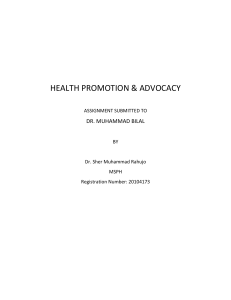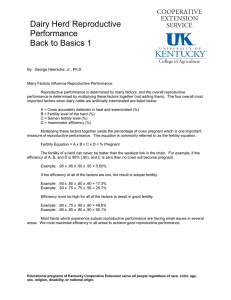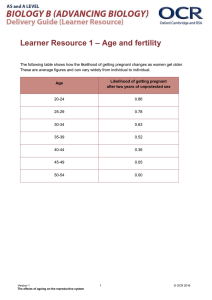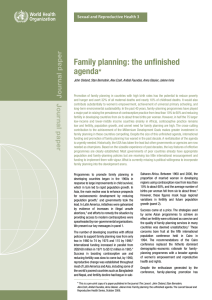The University of Texas at Austin, Department of Sociology Reproductive Health
advertisement
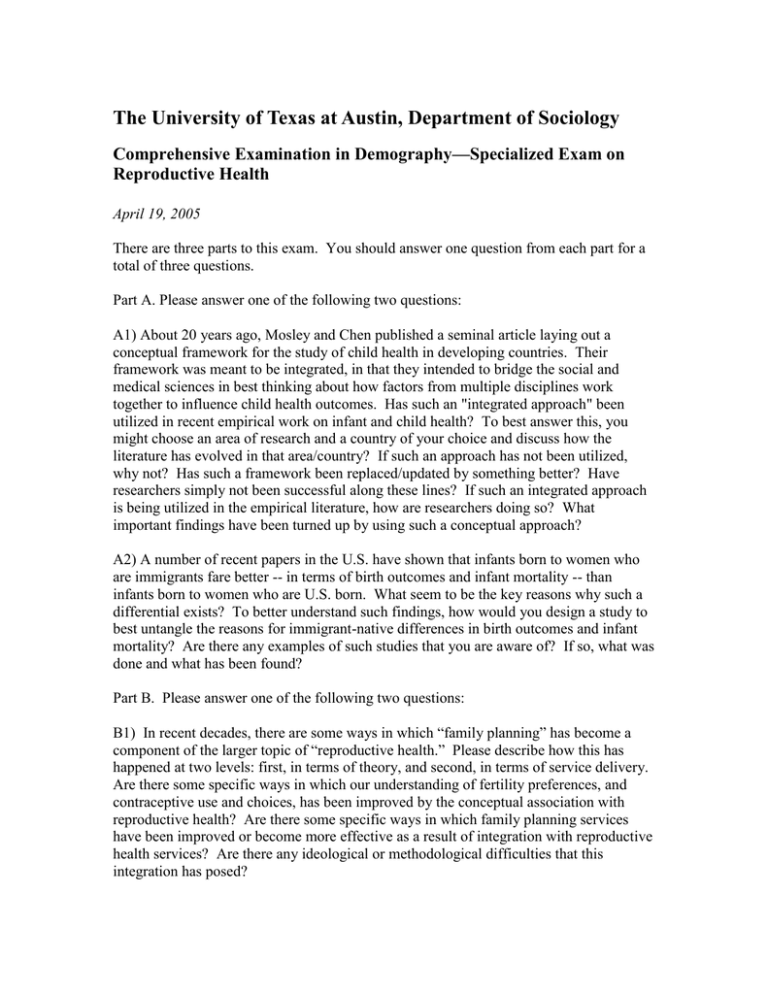
The University of Texas at Austin, Department of Sociology Comprehensive Examination in Demography—Specialized Exam on Reproductive Health April 19, 2005 There are three parts to this exam. You should answer one question from each part for a total of three questions. Part A. Please answer one of the following two questions: A1) About 20 years ago, Mosley and Chen published a seminal article laying out a conceptual framework for the study of child health in developing countries. Their framework was meant to be integrated, in that they intended to bridge the social and medical sciences in best thinking about how factors from multiple disciplines work together to influence child health outcomes. Has such an "integrated approach" been utilized in recent empirical work on infant and child health? To best answer this, you might choose an area of research and a country of your choice and discuss how the literature has evolved in that area/country? If such an approach has not been utilized, why not? Has such a framework been replaced/updated by something better? Have researchers simply not been successful along these lines? If such an integrated approach is being utilized in the empirical literature, how are researchers doing so? What important findings have been turned up by using such a conceptual approach? A2) A number of recent papers in the U.S. have shown that infants born to women who are immigrants fare better -- in terms of birth outcomes and infant mortality -- than infants born to women who are U.S. born. What seem to be the key reasons why such a differential exists? To better understand such findings, how would you design a study to best untangle the reasons for immigrant-native differences in birth outcomes and infant mortality? Are there any examples of such studies that you are aware of? If so, what was done and what has been found? Part B. Please answer one of the following two questions: B1) In recent decades, there are some ways in which “family planning” has become a component of the larger topic of “reproductive health.” Please describe how this has happened at two levels: first, in terms of theory, and second, in terms of service delivery. Are there some specific ways in which our understanding of fertility preferences, and contraceptive use and choices, has been improved by the conceptual association with reproductive health? Are there some specific ways in which family planning services have been improved or become more effective as a result of integration with reproductive health services? Are there any ideological or methodological difficulties that this integration has posed? B2) Caldwell, Phillips, and Barkat-e-Kuda (2002) wrote: “National family planning programs have been an important instrument in accelerating global fertility decline and in restricting ultimate world population to a level probably below ten billion. They began to come into being after 1950 and will probably go out of existence in most of the world’s regions by 2050.” They then take up the question of how well the 20th century programs worked, and what changes will be needed for the twenty-first century. What are some of the dramatic events that have occurred in recent years that have a bearing on the future of family planning programs, and what are some of the changes that those events will require? Part C. Please answer one of the following three questions: C1) There are several different ways in which religion or religiosity could potentially affect fertility. For example, organized religions can become political actors and alter the general availability of methods and information. A religion or denomination can have pro-natalist (or anti-natalist, for that matter) doctrines. The effect can be to alter fertility preferences, or use of contraception. Please extend this matrix of possible mechanisms and impacts and refer to relevant theoretical or empirical work. Second, explain how you might test the influence of a particular religion on fertility and contraceptive practice in a context of your choosing. C2) Cervical cancer screening by the Pap smear represents one of the very few costeffective interventions to prevent cancer. What are some of the obstacles to making greater and more effective use of cervical cancer screening in developing countries? Elaborate on the coverage attained in a context you are familiar with, and outline some of the steps that you believe should be taken to improve coverage in the future, noting the evidence on which your recommendations are based. C3. The “demographic dividend” is a contentious topic that seems to have divided the demographic community. Please provide a clear description of what is meant by this term, as well as an assessment of the evidence for this effect that has been amassed to date. Second, consider what would be involved in testing for the existence of such an effect within different geographical sub-units of a population, and how migration would enter into such an analysis.
